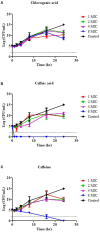Potential Antimicrobial Properties of Coffee Beans and Coffee By-Products Against Drug-Resistant Vibrio cholerae
- PMID: 35548583
- PMCID: PMC9083461
- DOI: 10.3389/fnut.2022.865684
Potential Antimicrobial Properties of Coffee Beans and Coffee By-Products Against Drug-Resistant Vibrio cholerae
Abstract
Vibrio cholerae is the causative organism of the cholera epidemic, and it remains a serious global health problem, particularly the multidrug-resistant strain, despite the development of several generic drugs and vaccines over time. Natural products have long been exploited for the treatment of various diseases, and this study aimed to evaluate the in vitro antibacterial activity of coffee beans and coffee by-products against V. cholerae antimicrobial resistant strains. A total of 9 aqueous extracts were investigated, including light coffee (LC), medium coffee (MC), dark coffee (DC), dried green coffee (DGC), dried red coffee (DRC), fresh red coffee (FRC), Arabica leaf (AL), Robusta leaf (RL), and coffee pulp (CP). The influential coffee phytochemicals, i.e., chlorogenic acid (CGA), caffeic acid (CA), and caffeine, were determined using HPLC. The antibacterial properties were tested by agar well-diffusion techniques, and the minimum inhibitory concentration (MIC) and minimum bactericidal concentration (MBC) were further determined against 20 V. cholerae isolates. The results revealed that all tested strains were sensitive to coffee extracts, with MIC and MBC values in the range of 3.125-25.0 mg/mL and 12.5-50.0 mg/mL, respectively. With a MIC of 6.25 mg/mL, DGC, DRC, and CP appeared to be the most effective compounds against 65, 60, and 55% of clinical strains, respectively. The checkerboard assay revealed that the combination of coffee extract and tetracycline was greater than either treatment alone, with the fractional inhibitory concentration index (FICI) ranging from 0.005 to 0.258. It is important to note that CP had the lowest FICI (0.005) when combined with tetracycline at 60 ng/mL, which is the most effective dose against V. cholerae six-drug resistance strains (azithromycin, colistin, nalidixic acid, sulfamethoxazole, tetracycline, and trimethoprim), with a MIC of 47.5 μg/mL (MIC alone = 12.5 mg/mL). Time killing kinetics analysis suggested that CA might be the most effective treatment for drug-resistant V. cholerae as it reduced bacterial growth by 3 log10 CFU/mL at a concentration of 8 mg/mL within 1 h, via disrupting membrane permeability, as confirmed by scanning electron microscopy (SEM). This is the first report showing that coffee beans and coffee by-product extracts are an alternative for multidrug-resistant V. cholerae treatment.
Keywords: Vibrio cholerae; antimicrobial activity; coffee by-products; coffee extract; drug-resistant.
Copyright © 2022 Rawangkan, Siriphap, Yosboonruang, Kiddee, Pook-In, Saokaew, Sutheinkul and Duangjai.
Conflict of interest statement
The authors declare that the research was conducted in the absence of any commercial or financial relationships that could be construed as a potential conflict of interest.
Figures



Similar articles
-
Antimicrobial Activity of the Green Tea Polyphenol (-)-Epigallocatechin-3-Gallate (EGCG) against Clinical Isolates of Multidrug-Resistant Vibrio cholerae.Antibiotics (Basel). 2022 Apr 13;11(4):518. doi: 10.3390/antibiotics11040518. Antibiotics (Basel). 2022. PMID: 35453268 Free PMC article.
-
Inhibitory activities of Typhonium trilobatum (L.) Schott on virulence potential of multi-drug resistant toxigenic Vibrio cholerae.Microb Pathog. 2022 Apr;165:105485. doi: 10.1016/j.micpath.2022.105485. Epub 2022 Mar 19. Microb Pathog. 2022. PMID: 35318072
-
Restoring Ampicillin Sensitivity in Multidrug-Resistant Escherichia coli Following Treatment in Combination with Coffee Pulp Extracts.J Microbiol Biotechnol. 2023 Sep 28;33(9):1179-1188. doi: 10.4014/jmb.2304.04051. Epub 2023 May 24. J Microbiol Biotechnol. 2023. PMID: 37317587 Free PMC article.
-
Inhibition of virulence potential of Vibrio cholerae by natural compounds.Indian J Med Res. 2011 Feb;133(2):232-9. Indian J Med Res. 2011. PMID: 21415500 Free PMC article. Review.
-
Antimicrobial resistance in Vibrio cholerae O1/O139 clinical isolates: a systematic review and meta-analysis.Expert Rev Anti Infect Ther. 2022 Sep;20(9):1217-1231. doi: 10.1080/14787210.2022.2098114. Epub 2022 Jul 13. Expert Rev Anti Infect Ther. 2022. PMID: 35790112
Cited by
-
Restoring Multidrug-Resistant Escherichia coli Sensitivity to Ampicillin in Combination with (-)-Epigallocatechin Gallate.Antibiotics (Basel). 2024 Dec 13;13(12):1211. doi: 10.3390/antibiotics13121211. Antibiotics (Basel). 2024. PMID: 39766601 Free PMC article.
-
Cholera Outbreaks in Zimbabwe: An In-Depth Analysis of Drivers, Constraints and Reimagining the Use of Medicinal Plants.J Trop Med. 2024 Nov 21;2024:1981991. doi: 10.1155/jotm/1981991. eCollection 2024. J Trop Med. 2024. PMID: 39620152 Free PMC article. Review.
-
Antibacterial Activity of Coffea robusta Leaf Extract against Foodborne Pathogens.J Microbiol Biotechnol. 2022 Aug 28;32(8):1003-1010. doi: 10.4014/jmb.2204.04003. Epub 2022 Jul 8. J Microbiol Biotechnol. 2022. PMID: 35879283 Free PMC article.
-
Green Nanoparticle Synthesis in the Application of Non-Bacterial Mastitis in Cattle.Molecules. 2025 Mar 18;30(6):1369. doi: 10.3390/molecules30061369. Molecules. 2025. PMID: 40142144 Free PMC article.
-
Native bacterial cellulose films based on kombucha pellicle as a potential active food packaging.J Food Sci Technol. 2023 Nov;60(11):2893-2904. doi: 10.1007/s13197-023-05808-x. Epub 2023 Aug 25. J Food Sci Technol. 2023. PMID: 37711573 Free PMC article.
References
-
- World Health Organization . Cholera Annual Report 2019 Weekly Epidemiological Record. Vol. 95, Report No. 38 (2020). p. 441–8.
-
- World Health Organization . Cholera Fact Sheet. (2021). Available online at: https://www.who.int/news-room/fact-sheets/detail/cholera (accessed January 4, 2022).
LinkOut - more resources
Full Text Sources
Other Literature Sources
Research Materials
Miscellaneous

